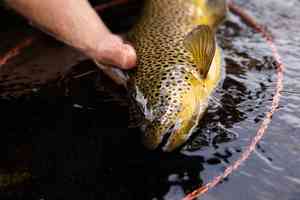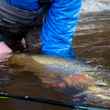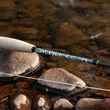Several winters ago, about the time I settled into wild trout country, I fell in love with winter fishing—the conditions, the solace, and the fish. For when the air turns cold, all but the hardiest abandon the water. The lucky angler may even find themselves solitary among mountains blanketed in white—the air aroar with the static of snowflakes crashing into Earth—and with an honest chance at a truly large trout that are relatively unpressured and intent on consuming the largest number of calories for the fewest expended. However, while fishing in the winter can be very productive and enjoyable, just like during the hot, low water summer and fall seasons, there are some oft-unconsidered catch and release concerns specific to the frosty months that should be kept in mind when handling fish.
Frozen Fish
There’s much debate within the fishing community over the ethics of fishing during specific times of the year and targeting fish during critical points in their life cycles. The spawn, post-spawn, low water, warm water—some even contest the act of fishing when air temperatures drop below the freezing mark. While such a self-imposed prohibition may seem a bit harsh, the motive is true.
Ever marvel at how quickly ice forms in your guides and your fly line turns into a frozen toothpick when angling in sub-freezing conditions? Or how cold your hands get after you get them wet? Fish are cold-blooded, and likewise their internal body temperatures are dictated by the temperature of their environment. Thus, while keeping fish out of the water for extended periods of time should always be avoided, special care should be taken when temperatures are below freezing. In particular, cold temperatures can cause severe damage to soft tissue, like eyes and gills, which are essential for survival.
To this end, whenever possible, keep fish in the water while handling, and unhooking them. You’ve heard of the “hold your breath when you pull a fish from the water” idea. Now imagine you’re soaking wet and your body temperature is plummeting. If you want to take a picture, keep the fish in a net while preparing the camera. It takes a second to release the shutter. Lift. Snap. Lower. Life. Snap. Lower. Release.
Remove Gloves
I rarely fish with gloves. Some like them. Regardless, it’s easy to be tempted to ignore effective catch and release practices in favor of warm, relatively dry, gloved hands.
It’s best to remove any kind of glove and wet your hands before handling a fish, for a photo or otherwise, as cloth is extremely adept at removing the protective slime layer that shields the fish from harmful fungi, bacteria, and ectoparasites. What’s more, imagine what those fish slime-covered gloves would have your truck smelling like by the first warm morning of spring.
This process can be totally avoided by keeping fish in a net in the water and using a pair of forceps to remove the hook before releasing, which also reduces air exposure to a minimum.
Keep Your Hands Warm
But what about those hands? Now they’re all wet and feeling like a winter fish out of water, which may pose a risk to your own health. If you don’t get them warm, you’ll be tempted even further to put those gloves back on and keep them on (if you’ve got them), taking life-threatening chances with every consequent fish you catch.
When fishing in cold or below-freezing conditions, consider carrying a small microfiber towel tucked in the front of your waders. When your hands get wet or fish-slimy, just dry them off, warm them up inside the upper chest of your jacket, and keep fishing, or replace the glove you took off to handle that fish. It might end up pretty rank, but towels are a lot easier to wash at the end of a season than a pair of good fishing gloves.
Catch and release practices are pounded into angling minds constantly, and are often centered on the dangers of the upper temperature extreme. Although winter fishing can be some of the best of the year, both for the experience and the catching, the effect of cold air on fish and our handling of them should be kept in mind, with the goal of watching that fish return to its lie to haunt another angler in the days and years to come.




























Comments
Jared MacGowan replied on Permalink
Does anyone have an info about the damage placing trout on snow or ice can do? I have heard it can be really hard on the trout, but can't find any research that confirms it. Good article though!
Anonymous replied on Permalink
Nice article, thanks.
Stephen Wisner replied on Permalink
Obviously, being careful and expedient when releasing fish is essential, but the idea that gills and eyes freeze instantly when out of water on a cold day just isn't true. Here's what my discussion with a biologist turned up on this topic
While fish are cold blooded, it doesn't mean that they have no body temperature. If a fish is in 40 degree water, it has a body temperature of roughly 40 degrees. So the blood flowing through its very red gills is 40 degrees and will be keeping them warm exactly the same way a warm blooded creature's blood keeps its cells warm. Sure, eventually (think hours) that blood would cool, but we're talking about seconds here.
In addition, a fish carefully lifted out of 40 degree water has a layer of 40 degree water covering it. The cells beneath that water won't freeze until the water layer freezes and when it freezes (which it won't because you will have removed the barbless hook and put the fish back before it can), it will be at 32 degrees, essentially creating a protective layer from colder air temperatures. Think orange crops sprayed with water before a freeze.
It short, we need to be careful with fish in the winter exactly the same way we do in the summer. Keep them wet, use barbless hooks, and release them as quickly as possible.
Shreve replied on Permalink
Well stated.
Anonymous replied on Permalink
So nice to see conscience fisherman concerned about the handling of fish. Have pretty much tried to get away with even netting fish anymore, little bigger leader allows quicker fight and can control fish to point of subduction and release, never leave the water
Jay replied on Permalink
You can release fish without lifting them from the water or handling them. Slide your hand down the leader and grasp the fly as near to the bend of your barbless hook as possible. Calmly and smoothly release tension on the leader and lightly twist the hook free without ever lifting the fish from the water. You are of course not "playing" fish to exhaustion and using as stout a tippet as practical. This can be done with or without a net. If the fish is deeply hooked - cut the leader.
Ken Neubecker replied on Permalink
If its sub freezing, I don't fish. Icing guides and lines are a pain, but not near the pain the fish feel.
Lee Ann replied on Permalink
Use a Ketchem Release tool and you don't have to touch the fish at all.
Joe GaNun replied on Permalink
Several above referenced barbless. That might be the best overall advice for "stress" water fishing. I have taken to the habit of releasing pressure when the fish is close enough to net. It's amazing how many times they simply shake the hook. Especially big momma.
Christopher replied on Permalink
I don't know, maybe one could skip the photo?
You know that you caught the fish, the fish knows that you caught it, and if your spouse does not believe you, trade them in.
Bolderado replied on Permalink
So easy. Don't handle the fish and don't remove them from the water. All is good!
Bob replied on Permalink
Generally we (fisher persons) feel better about catch and release then the creature we are catching ? Does it promote survivability for the fish ? I don't believe so. I've heard a story from an experienced guide that he has caught the same brown over the years...but with the additional wounds. I've changed my point of view lately...the conundrum of hatcheries and wild trout has me rethinking fly fishing and fishing in general. So a discussion about fishing in winter to me doesn't really matter. I'm coming to the conclusion that all fish caught should be harvested...but seasons must be shorter and harvesting much more selective.
John Brewer replied on Permalink
Very useful article, many thanks! Answers critical questions I've had about winter fishing.
Robbins Church replied on Permalink
Nice article. Nice discussions. Well done, all around!
lance magnuson replied on Permalink
I fish all winter both streams and lowland lakes. My go to for hand protection from cold is glove liners worn under nitrile gloves. I use fingerless gloves over the top. I’m still able to tie knots and when handling fish, nitrile gloves when wet, do not remove protective slime from fish.
Pages